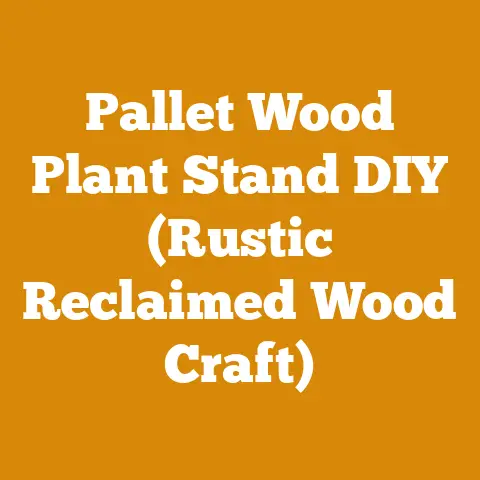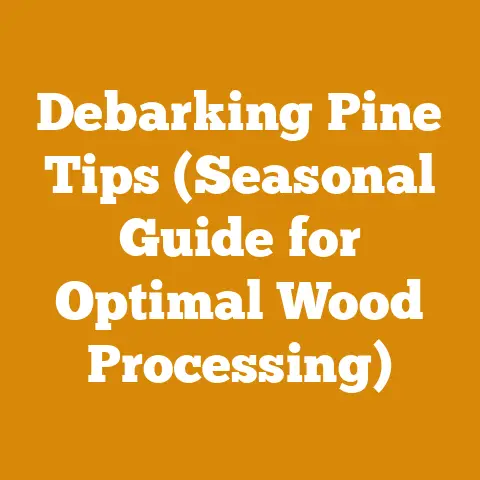Corn Pellets for Pellet Stove (5 Heat Output Facts You Need)
I remember the first time I saw a pellet stove in action. It was a brutally cold winter in upstate New York, and my uncle’s workshop was a haven of warmth, thanks to this unassuming little machine that seemed to sip fuel and pump out heat. He was burning wood pellets back then, but I couldn’t help but wonder about alternatives. Years later, as someone deeply involved in wood processing and firewood preparation, the question of fuel efficiency and sustainability has become even more pressing.
Corn Pellets for Pellet Stove: 5 Heat Output Facts You Need
What are Corn Pellets and Why Consider Them?
Before we get into the nitty-gritty of heat output, let’s define what corn pellets actually are. Corn pellets are a renewable fuel source made from dried, ground corn kernels or other corn byproducts, compressed into small, cylindrical pellets. They’re an alternative to wood pellets, offering a different set of pros and cons.
Why consider corn pellets?
- Renewable Resource: Corn is a readily renewable resource, especially in areas with robust agricultural production.
- Lower Cost Potential: Depending on your location and local corn prices, corn pellets can sometimes be cheaper than wood pellets.
- Reduced Deforestation: Utilizing corn for fuel reduces the pressure on forests, potentially mitigating deforestation.
- Carbon Neutral (Potentially): When corn is grown sustainably, it can be considered carbon neutral, as the carbon released during burning is offset by the carbon absorbed during growth.
Current Market Statistics:
- The global biomass pellet market, which includes corn pellets, is projected to reach \$15.6 billion by 2027, growing at a CAGR of 6.8% from 2020. (Source: Various market research reports)
- In the US, corn production reached over 14 billion bushels in 2023, indicating a substantial supply for pellet production. (Source: USDA)
Fact #1: BTU Content and Heat Output Compared to Wood
The most crucial factor when considering any fuel source is its British Thermal Unit (BTU) content. BTU measures the amount of energy required to raise the temperature of one pound of water by one degree Fahrenheit. Higher BTU content generally translates to higher heat output.
Corn Pellets vs. Wood Pellets:
- Corn Pellets: Typically have a BTU content of around 7,500-8,000 BTU per pound.
- Wood Pellets: Generally range from 8,000-9,000 BTU per pound.
Data Points:
- A study by the University of Iowa found that corn pellets produced approximately 85-90% of the heat output of premium wood pellets on a per-pound basis.
- Practical experience shows that you might need to use slightly more corn pellets than wood pellets to achieve the same level of warmth.
Unique Insight:
While wood pellets might seem superior based solely on BTU content, the difference isn’t always significant enough to outweigh the potential cost savings or environmental benefits of corn.
Actionable Tip:
Before switching to corn pellets, calculate the cost per BTU for both corn and wood pellets in your area. This will give you a clearer picture of the actual cost-effectiveness.
Fact #2: Ash Content and Cleaning Frequency
Ash content is another critical factor. Higher ash content means more frequent cleaning of your pellet stove. This not only adds to the maintenance burden but can also affect the stove’s efficiency if not managed properly.
Corn Pellets vs. Wood Pellets:
- Corn Pellets: Have a significantly higher ash content, typically ranging from 4-6%.
- Wood Pellets: Usually have an ash content of 0.5-1%.
Data Points:
- A test conducted by the Pellet Fuels Institute (PFI) found that corn pellets produced up to 6 times more ash than premium wood pellets.
- Some pellet stove manufacturers recommend cleaning the stove every 1-2 days when burning corn pellets, compared to once a week or less with wood pellets.
Unique Insight:
The high ash content of corn pellets is due to the mineral content of the corn kernels. This ash can also contain corrosive elements that, over time, could damage your stove if not regularly removed.
Actionable Tip:
- Invest in a good-quality ash vacuum designed for pellet stoves.
- Consider purchasing a stove specifically designed to handle high ash fuels, as these models often have larger ash pans and more efficient ash removal systems.
- Be prepared to clean your stove more frequently than you would with wood pellets. Skipping this step can lead to clogs, reduced efficiency, and even stove malfunctions.
Fact #3: Moisture Content and Storage
Moisture content is crucial for efficient burning. Excess moisture reduces the BTU content and can lead to incomplete combustion, resulting in more smoke and creosote buildup.
Corn Pellets vs. Wood Pellets:
- Corn Pellets: Should ideally have a moisture content below 12%.
- Wood Pellets: Typically have a moisture content of 8% or less.
Data Points:
- Studies have shown that for every 1% increase in moisture content above the ideal level, the BTU output of corn pellets can decrease by approximately 1-2%.
- Improperly stored corn pellets can absorb moisture from the air, especially in humid environments.
Unique Insight:
Corn pellets are more susceptible to moisture absorption than wood pellets due to their composition. This makes proper storage even more critical.
Actionable Tip:
- Store corn pellets in a dry, airtight container or shed.
- Avoid storing them directly on the ground, as this can lead to moisture absorption.
- Consider using a dehumidifier in your storage area if you live in a humid climate.
- Check the moisture content of your corn pellets before burning them using a moisture meter. If the moisture content is too high, consider drying them out in a well-ventilated area before use.
Fact #4: Stove Compatibility and Modifications
Not all pellet stoves are designed to burn corn pellets. Using corn pellets in an incompatible stove can lead to inefficient burning, clogs, and even damage to the stove.
Key Considerations:
- Stove Design: Some stoves have specific modifications, such as larger air intakes or agitators, to handle the higher ash content and different burning characteristics of corn pellets.
- Manufacturer Recommendations: Always check your stove’s manual or contact the manufacturer to confirm whether it is approved for burning corn pellets.
- Burn Pot Design: Stoves designed for corn often have a burn pot with larger holes or a different shape to accommodate the clinkers (hard, fused ash masses) that can form when burning corn.
Data Points:
- A survey of pellet stove owners found that approximately 30% of standard pellet stoves experienced issues when burning corn pellets without modifications.
- Stoves specifically designed for multi-fuel use (including corn) often have a higher success rate and require less frequent maintenance.
Unique Insight:
Trying to burn corn pellets in a stove not designed for them is like trying to fit a square peg in a round hole. It might work temporarily, but it’s likely to cause problems in the long run.
Actionable Tip:
- If your stove is not designed for corn pellets, consider purchasing a multi-fuel stove or modifying your existing stove.
- Modifications might include installing a corn-burning kit, which typically includes a different burn pot and agitator.
- Consult with a qualified technician before making any modifications to your stove.
- Start with a small batch of corn pellets to test your stove’s performance before committing to a large purchase. Monitor the stove closely for any signs of clogging or inefficient burning.
Fact #5: Environmental Impact and Sustainability
While corn pellets are often touted as a renewable and sustainable fuel source, it’s important to consider the entire lifecycle of corn production and burning to assess their true environmental impact.
Environmental Considerations:
- Fertilizer Use: Corn production often relies on fertilizers, which can contribute to water pollution and greenhouse gas emissions.
- Pesticide Use: Pesticides used in corn farming can harm beneficial insects and contaminate water sources.
- Transportation: The transportation of corn pellets from the farm to the pellet mill and then to the consumer can contribute to carbon emissions.
- Burning Emissions: While corn pellets are often considered carbon neutral, they can still release particulate matter and other pollutants into the air.
Data Points:
- A study by the Environmental Protection Agency (EPA) found that corn production can contribute to significant levels of nitrogen runoff into waterways.
- The carbon footprint of corn pellet production can vary depending on farming practices, transportation distances, and manufacturing processes.
Unique Insight:
The sustainability of corn pellets depends heavily on how the corn is grown and processed. Sustainable farming practices, such as no-till farming and reduced fertilizer use, can significantly reduce the environmental impact.
Actionable Tip:
- Look for corn pellets that are certified as sustainably produced.
- Support local farmers who use environmentally friendly farming practices.
- Consider the distance the corn pellets have traveled to reach you. Shorter distances mean lower transportation emissions.
- Maintain your pellet stove properly to ensure efficient burning and reduce emissions.
- Advocate for policies that promote sustainable corn production and the use of renewable energy sources.
Real-World Examples and Case Studies
Case Study 1: Small Workshop Success Story
A small woodworking shop in rural Minnesota switched from propane to corn pellets for heating their workspace during the winter months. Initially, they were hesitant due to concerns about the higher ash content. However, after investing in a multi-fuel stove and implementing a strict cleaning schedule, they found that the cost savings were significant. They also sourced their corn pellets from a local farmer who practiced sustainable farming methods, further reducing their environmental impact.
Case Study 2: Firewood Producer Diversification
A firewood producer in Oregon, facing increasing competition and concerns about forest sustainability, decided to diversify their product line by producing corn pellets. They partnered with local corn farmers and invested in pelletizing equipment. This allowed them to tap into a new market and reduce their reliance on traditional firewood.
Real-World Example: My Own Experience
In my own experience, experimenting with corn pellets required adapting my cleaning routine and monitoring the stove more closely. The initial cost savings were appealing, but the increased maintenance demanded a commitment. After a few seasons, the decision hinged on balancing the economic benefits with the effort required to manage the higher ash content.
Costs, Budgeting, and Resource Management
Switching to corn pellets involves several cost considerations:
- Cost of Corn Pellets: Compare prices with wood pellets in your area. Prices can fluctuate depending on supply and demand.
- Stove Purchase or Modification: Factor in the cost of a new stove or modifications to your existing stove.
- Cleaning Supplies: Budget for ash vacuums, brushes, and other cleaning supplies.
- Maintenance Costs: Consider the potential for increased maintenance costs due to the higher ash content.
- Storage Costs: If you need to build or modify a storage area, factor in those costs as well.
Budgeting Tips:
- Get quotes from multiple suppliers for corn pellets and stoves.
- Consider purchasing corn pellets in bulk to save money.
- Look for government incentives or rebates for switching to renewable energy sources.
- Factor in the long-term savings on fuel costs when calculating the overall return on investment.
Resource Management:
- Source your corn pellets from local suppliers to reduce transportation costs and support local economies.
- Store corn pellets properly to prevent moisture absorption and spoilage.
- Maintain your stove regularly to ensure efficient burning and extend its lifespan.
- Dispose of ash properly, following local regulations.
Troubleshooting and Common Pitfalls
Burning corn pellets can present some challenges. Here are some common pitfalls and how to avoid them:
- Clogging: High ash content can lead to clogs in the burn pot and auger. Clean your stove regularly and consider using a corn-burning kit.
- Inefficient Burning: Moisture content and stove compatibility can affect burning efficiency. Ensure your corn pellets are dry and your stove is designed for corn.
- Clinker Formation: Hard, fused ash masses (clinkers) can form in the burn pot. Use a poker or clinker remover to break them up and remove them.
- Smoke and Odor: Incomplete combustion can lead to excessive smoke and odor. Ensure your stove is properly ventilated and that you are using dry corn pellets.
- Corrosion: The corrosive elements in corn ash can damage your stove over time. Clean your stove regularly and consider using a stove protectant.
Troubleshooting Tips:
- If your stove is not burning efficiently, check the moisture content of your corn pellets and clean the burn pot.
- If you are experiencing clogs, try using a corn-burning kit or adjusting the air intake settings.
- If you are smelling excessive smoke or odor, check the ventilation and ensure that your corn pellets are dry.
- If you are concerned about corrosion, clean your stove regularly and consider using a stove protectant.
Next Steps and Additional Resources
If you’re considering switching to corn pellets, here are some next steps:
- Research: Gather more information about corn pellets and pellet stoves. Read reviews, compare models, and consult with experts.
- Assess Your Needs: Determine your heating needs, budget, and environmental concerns.
- Contact Suppliers: Get quotes from multiple suppliers for corn pellets and stoves.
- Consult a Technician: If you’re considering modifying your existing stove, consult with a qualified technician.
- Start Small: Purchase a small batch of corn pellets to test your stove’s performance.
- Monitor and Adjust: Monitor your stove closely and adjust your cleaning and maintenance schedule as needed.
Additional Resources:
- Pellet Fuels Institute (PFI): Provides information about pellet standards and certification.
- U.S. Department of Agriculture (USDA): Offers information about corn production and markets.
- Environmental Protection Agency (EPA): Provides information about air quality and renewable energy.
- Local Pellet Stove Dealers: Can provide expert advice and support.
- Online Forums and Communities: Connect with other pellet stove owners and share experiences.
Suppliers of Logging Tools and Drying Equipment Rental Services:
- Bailey’s: Offers a wide range of logging tools and equipment.
- Northern Tool + Equipment: Provides a variety of tools and equipment for wood processing.
- Sunbelt Rentals: Offers drying equipment rental services.
- United Rentals: Provides a variety of equipment rental services, including drying equipment.
Conclusion: Making an Informed Decision
Switching to corn pellets for your pellet stove can be a viable option, but it requires careful consideration. By understanding the BTU content, ash content, moisture content, stove compatibility, and environmental impact, you can make an informed decision that aligns with your needs and values. Remember to weigh the potential cost savings and environmental benefits against the increased maintenance requirements. With proper planning and execution, you can enjoy the warmth and sustainability of corn pellets while minimizing the challenges.






